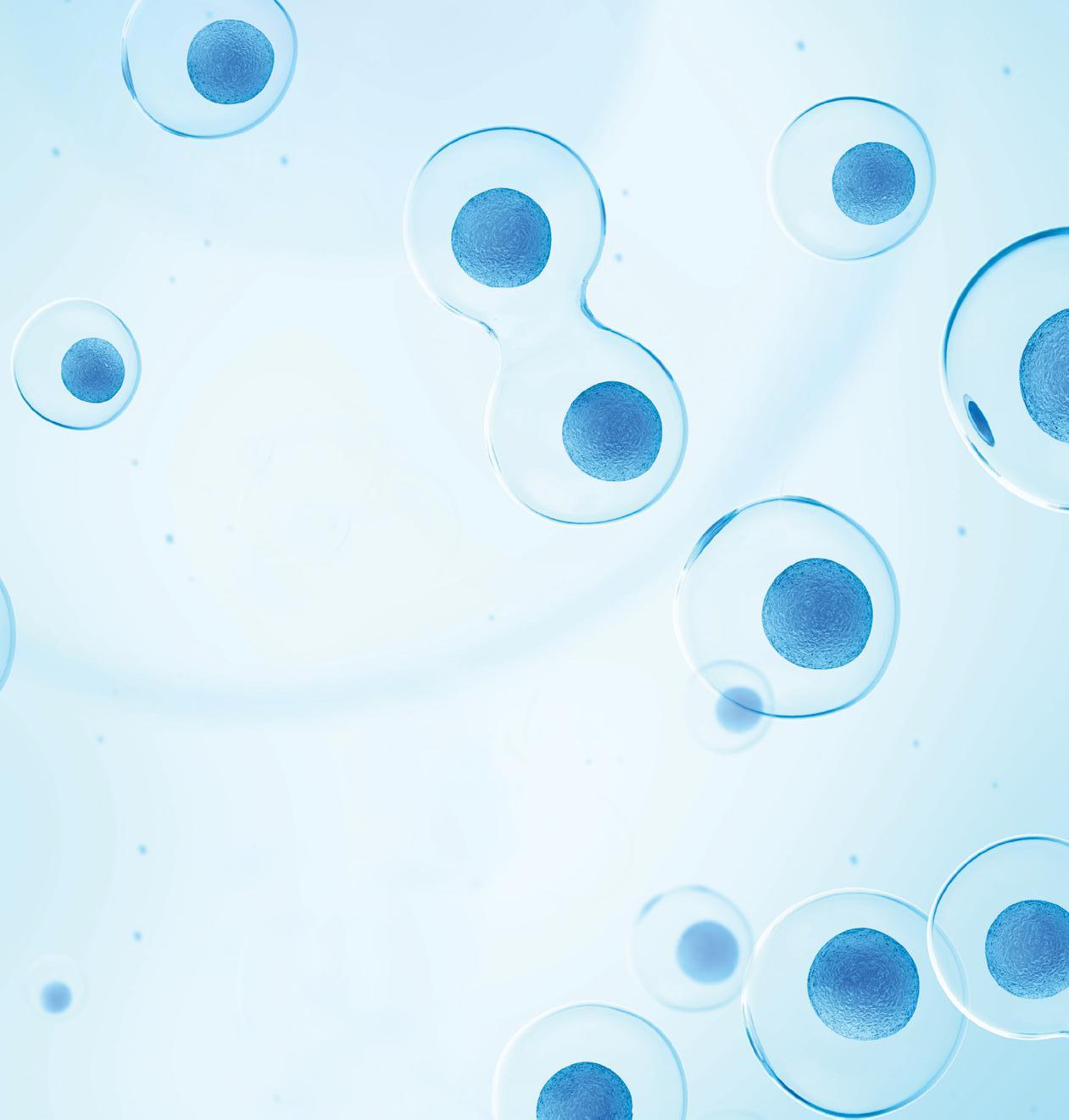
11 minute read
DIM from Cruciferous Vegetables for Men’s Health
By: Whitney Crouch, RDN, CLT
The following arti cle is not endorsed and/or supported by The American Academy of Anti -Aging Medicine. The purposes of this publicati on do not imply endorsement and/or support of any author, company or theme related to this arti cle.
Cruciferous vegetables belong to the
Brassica genus of plants and include foods such as broccoli, arugula,
Brussels sprouts, mustard and collard greens, cabbage, and watercress.
Known for their cancer-fi ghting biological properties and support of the body’s natural detoxifi cation system, these veggies contain sulfur-containing chemicals called glucosinolates, which are responsible for the vegetable’s pungent aroma and bitter fl avor. 1
During the digestion of cruciferous vegetables, glucosinolates are broken down to form biologically active compounds such as indoles, nitriles, thiocyanates, and isothiocyanates. 2 One of these compounds, indole-3- carbinol (I3C), is then converted into 3,3’-diindolylmethane (DIM) in the stomach; both compounds are known for their health supportive characteristics. 3 Studies investigating these unique nutritional bioactives, I3C and DIM, have found that I3C is unstable in the acidic stomach acid environment and is rapidly converted to DIM. 4 To simplify the discussion, some of the observed eff ects of I3C will be assumed for DIM, except for any dose-specifi c references. 4-6
I3C and DIM are best known for their use in cancer prevention applications and female hormone balance, with DIM regarded as a go-to support for reducing excess estrogens in the body. 7- 8 While it’s predominantly regarded as a women’s health ingredient, DIM is not a compound just for women.
DIM FOR MEN
Prostate Cancer Prostate cancer is the most common nonskin cancer in American men, with a lifetime
risk for diagnosis of approximately 15.9%. 9 It is estimated that 164,690 new cases were diagnosed, and 29,430 patients died from prostate cancer in 2018. 9
Nutrition represents a modifi able cancer risk factor that practitioners can and should leverage in their patients. Epidemiological evidence demonstrates that consumption of cruciferous foods has been associated with decreased prostate cancer incidence 10 and risk. 11 So, how much broccoli, you ask? Consuming ≥ 3 servings of cruciferous vegetables (as compared to < 1 serving/ week) was associated with a 41% risk reduction in prostate cancer. 11
Crucifer bioactives I3C and DIM have been studied for their anticancer pathophysiological properties. Mechanistically, it is thought that the antiprostate cancer eff ects of I3C and DIM are driven by DIM’s inhibitory eff ects on androgen-mediated pathways, meaning multiple testosterone-producing pathways are reduced through diff erent mechanisms of DIM’s bioactivity. 8 Furthermore, DIM imparts anti-cancer eff ects via its ability to reduce cell proliferation, provoke cell cycle arrest, induce cell death (apoptosis) and autophagy in human prostate cancer cells. 12-13
A preclinical study in a mouse model found that a combination of DIM (10 mg/kg) and chloroquine (60 mg/kg), taken 3x/week, signifi cantly decreased prostate cancer (PC-3) tumor growth in vivo after 3 and 4 weeks of treatment. 10
The mouse prostate cancer model used was a unique one, as the researchers performed a xenograft (i.e., tissue graft from a donor of a diff erent species from the recipient) of human prostate cancer cells A more active type of DIM, 4,4’-Br2DIM, given at the same dose (10 mg/kg, 3x/week) was found to signifi cantly inhibit tumor growth after 4 weeks of treatment, making DIM a novel addition to prostate health plans and prostate cancer treatments. 10 Translation: DIM paired with chloroquine for 3 to 4 weeks can slow prostate tumor progression.
Next, a clinical study used a nutritional grade, absorption-enhanced DIM (BR-DIM) given in 225 mg doses 2x/ day for a minimum of 14 days in 41 Caucasian (55%) and African American (40%) patients with localized prostate cancer.1 3 Baseline plasma DIM blood levels were assessed in patients, who were given BR-DIM for 14-72 days before undergoing a radical prostatectomy; blood DIM levels were re-tested immediately prior to surgery and during a followup to surgery within 24 months postoperation. Prostate tissue DIM was also measured at the time of surgery.
Biologically signifi cant levels of DIM concentrations were found in
prostate tissue by day 14 of BR-DIM supplementation, with no incremental increases achieved with BR-DIM treatment of longer duration. 13 Further, a reduction in PSA levels was observed in the majority (71%) of study participants. 13 Lastly, BRDIM had a signifi cant, anti-androgenic impact on the nuclear translocation of the androgen receptor (i.e., exclusion from the nucleus) in 96% of patients; this receptor plays a key role in prostate tumor pathogenesis via testosterone binding. 13 Translation: BR-DIM treatment produced clinically relevant DIM levels in the prostate and reduced the eff ectiveness of androgen receptors to bind testosterone, which has potential chemopreventive implications for prostate cancer.
Finally, a double-blind, randomized, placebo-controlled clinical trial examined the effi cacy of a pharmaceutical DIMcontaining drug (900 mg/day DIM) in 21 patients with high-grade prostatic intraepithelial neoplasia (PIN), a major risk factor for development of prostate cancer. 14 An interim analysis of data after 12 months of treatment demonstrated a signifi cant reduction in the morphological index (based on histological examination of prostate biopsy specimens) in the treatment group as compared to placebo. 14 Additional treatment group eff ects include an improvement in maximal urinary fl ow rate and a complete regression of PIN in 45% of patients. Translation: intermediate results from a DIM drug trial demonstrate signifi cant clinical promise for patients with high-grade PIN. Other male-centric hormonal applications In addition to its aforementioned role in hormone-related prostate cancer, DIM may support other areas of men’s health.
Obesity A preclinical study in mice compared the eff ects of a high-fat diet (HFD) vs. control diet within the context of DIM supplementation. 15 In the mice fed the HFD, 50 mg DIM per kg body weight suppressed HFD-induced obesity; the group receiving the HFD alone gained weight and fat tissue, while the group receiving the HFD plus DIM did not gain weight nor adipose tissue, likening them to the control diet group. 15 Furthermore, cellular analyses revealed that DIM signifi cantly inhibited adipogenesis of pre-adipocyte cells. 15 In other words, DIM has anti-obesity properties.
Estrogen-Related Effects More often discussed in women’s health conversations, one well-known characteristic of DIM is its ability to reduce excess estrogen in the body and convert the more carcinogenic type of estrogens (16-hydroxy and 16-methoxy estrogens) into the “good estrogens” (2-hydroxy and 2-methoxy estrogens). 16 But, men make estrogens too through the conversion of testosterone into estradiol via the aromatase enzyme. By DIM reducing excess estrogens in men (possibly caused by genetics, diet, or xenoestrogen exposure), there may also be a reduction in estrogen-excess symptoms like fatigue, erectile dysfunction, obesity, and estrogen-related cancers. 15-16
Clinical Takeaways:
DIM is not just an indole phytochemical that supports women’s health, but men’s health as well
DIM may be used as a preventative measure in men with certain risk factors for prostate cancer (e.g., PIN), and as an adjunct therapy during conventional treatment for certain types of prostate cancers
DIM may support healthy testosterone-to-estrogen balance in males, which in turn can improve myriad symptoms and clinical manifestations of estrogen excess
If you suspect estrogen excess or would like to learn more about DIM’s appropriateness for a specifi c prostate condition, consult with a qualifi ed healthcare provider for hormone testing and personalized clinical recommendations.
CITATIONS
1. NIH. Cruciferous vegetables and cancer prevention. https://www.cancer.gov/ about-cancer/causes-prevention/risk/diet/cruciferous-vegetables-fact-sheet.
Accessed December 18, 2018. 2. Hayes JD et al. The cancer chemopreventive actions of phytochemicals derived from glucosinolates. Eur J Nutr. 2008;47 Suppl 2:73-88. 3. Li Y et al. Recent progress on nutraceutical research in prostate cancer. Cancer Metastasis Rev. 2014;33(2-3):629-640. 4. Anderton MJ et al. Pharmacokinetics and tissue disposition of indole-3- carbinol and its acid condensation products after oral administration to mice.
Clin Cancer Res. 2004;10:5233–5241. 5. Weng JR et al. Indole-3-carbinol as a chemopreventive and anti-cancer agent.
Cancer Lett. 2008;262:153–163. 6. Grose KR et al. Oligomerization of indole-3-carbinol in aqueous acid. Chem
Res Toxicol. 1992;5:188–193. 7. Murillo G et al. Cruciferous vegetables and cancer prevention. Nutr Cancer. 2001;41(1-2):17-28. 8. Wang TT et al. Broccoli-derived phytochemicals indole-3-carbinol and 3,3’-diindolylmethane exerts concentration-dependent pleiotropic effects on prostate cancer cells: comparison with other cancer preventive phytochemicals. Mol Carcinog. 2012;51(3):244-256. 9. Siegel RL et al. Cancer statistics, 2018. CA Cancer J Clin. 2018;68:7–30. 10. Kristal AR et al. Brassica vegetables and prostate cancer risk: a review of the
epidemiological evidence. Nutr Cancer. 2002;42(1):1-9. 11. Cohen JH et al. Fruit and vegetable intakes and prostate cancer risk. J Natl
Cancer Inst. 2000;92(1):61-68. 12. Draz H et al. Autophagy inhibition improves the chemotherapeutic efficacy of cruciferous vegetable-derived diindolylmethane in a murine prostate cancer xenograft model. Invest New Drugs. 2018;36(4):718-725. 13. Hwang C et al. Anti-androgenic activity of absorption-enhanced 3, 3’-diindolylmethane in prostatectomy patients. Am J Transl Res. 2016;8(1):166-176. 14. Paltsev M et al. First results of the double-blind randomized placebocontrolled multicenter clinical trial of DIM-based therapy designed as personalized approach to reverse prostatic intraepithelial neoplasia (PIN).
EPMA J. 2016;7:5. 15. Yang H et al. 3,3’-Diindolylmethane suppresses high-fat diet-induced obesity through inhibiting adipogenesis of pre-adipocytes by targeting USP2 activity.
Mol Nutr Food Res. 2017;61(10). 16. Wendlová J. Scientific medicine in integrative treatment of erectile dysfunction. J Integr Nephrol Androl. 2015;2:5-18 17. Wu F et al. Levels of estradiol and testosterone are altered in Chinese men with sexual dysfunction. Andrology. 2016;4(5):932-938.
WHITNEY CROUCH, RDN, CLT
Whitney Crouch is a Registered Dietitian who received her undergraduate degree in Clinical Nutrition from the University of California, Davis. She has over 10 years of experience across multiple areas of dietetics, specializing in integrative and functional nutrition and food sensitivities. When she’s not writing about nutrition or educating others, she’s spending time with her husband and young son. She’s often found running around the bay near her home with the family’s dog or in the kitchen cooking up new ideas to help her picky eater expand his palate.
A Comprehensive Range of Practitioner-Grade Formulas to Support Hormone Health
Hormones are involved in most basic processes within the body for both men and women. Hormones play a role in a variety of general and sex-specific functions, including mood, sexual libido, premenstrual syndrome (PMS), weight management, and energy levels. Metagenics builds upon this science to offer an extensive line of nutritional formulas that target specific support areas for men’s and women’s hormonal health.*
• Axis Endo™
Specialized support for hormone metabolism in men and women*
• EstroFactors®
Features phytonutrients and BioResponse DIM®
• Meta I 3 C®
Designed to promote healthy estrogen metabolism and balance*
• Testralin®
Testosterone balance support*
Contact your Metagenics representative today to learn more, or visit Metagenics.com
We Offer: We Offer: Comin Comi g Soon: ng Soon:
FIT 176 Test FAST Test FIT 1 FI 7 T 6 1 Te 32 st Test FAST Test New Zonulin FIT 132 Test FIT 22 Test COVID-19 FIT 22 Test COVID-19 Antibody Test New Zonulin Assay COVID PCR Test Assay COVID PCR Test Antibody Zonuli Test n Test





Zonulin Test





The test measures the senitivity t Th o 1 e t 76 est foo meas ds, col u o r r es ing th s, e se and nitivity ad to diti 176 ves s fo pa o n ds, nin c g olori all m n aj g o s r , and additives food spanni groups. ng all major food groups.



MODULES AVAILABLE LIVE & ONLINE

Learn more about Aesthetic Medicine, one of the fastest growing and most profitable sectors in healthcare, through our Aesthetics Fellowship: a program that combines audiovisual lectures with hands-on clinical tutorials, and allows participants to learn the multiple benefits and applications of Aesthetic Medicine.
COURSE CURRICULUM
• 3 Didactic Modules • 4 Hands-On Training Modules • Level 4 Certification
TOPICS INCLUDE
Botox and Filler Injections
Laser and Light Treatments

by Emerson Ecologics
The Only Virtual Dispensary ® Solution With a Patient Mobile App
A modern way to keep your patients connected with your practice and engaged with your dispensary.
Clear Plans & Recommendations Personalized recommendation/treatment plans with links to recommended products and dosage instructions (frequency, duration, etc.) to eliminate any guesswork or substitutes.
Better Patient Connections Simple-to-use technology offering anytime, anywhere access makes patients feel like you’re with them. More ways to order gives patients more reasons to refill with you.
Unparalleled Product Selection Recommend from 350+ premier brands, always in stock and ready to ship.
Grow Your Practice Earn more revenue without managing costly inventory. Auto-refills mean more income for you--not Amazon. Free shipping on orders of $49 or more!

BECOME A MEMBER

Membership Includes:
Join the Fastest Growing Medical Specialty ❑ Most recently released benefit: A Digital Health Guide, part of a ✓ personalized & programmable wellness platform for providers & patients ❑ Directory listing on A4M.com ✓ ❑ Custom optimization of your directory listing for more patient views & traffic ✓ ❑ Framed membership certificate ✓ ❑ Up to 50% savings on conferences ✓ ❑ Access to a medical insurance agency with expertise in Anti-Aging Medicine ✓



